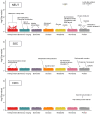A comprehensive phenome wide analysis of the role of neutrophils in health and disease
- PMID: 40435322
- PMCID: PMC12257109
- DOI: 10.1093/jleuko/qiaf076
A comprehensive phenome wide analysis of the role of neutrophils in health and disease
Abstract
Neutrophil release of cytoplasmic granules containing antimicrobial agents is a critical component of innate immunity. Neutrophils are widely implicated in tissue inflammation however the extent of the neutrophil contribution to human health and disease is incompletely characterized. To explore this further, we leveraged publicly available genetic data to conduct a Mendelian randomization phenome-wide association study (MR-PheWAS) of neutrophil traits and 14,983 outcomes. Genetic proxies for neutrophil count, granularity, and serum myeloperoxidase were linked to 145 outcomes. Higher neutrophil count was associated with lower body weight, reduced obesity risk, and increased vascular activation markers but not with atherosclerosis. Elevated neutrophil count was robustly linked to Alzheimer's disease and neutrophil granularity with gut microbiota abundance and dental pathology. Our findings reveal the diverse roles of neutrophils extending beyond pathogen defense and underscore the potential for MR-PheWAS in identifying novel neutrophil-related pathophysiology.
Keywords: Mendelian randomization; genome-wide association study; neutrophil; phenome-wide association study.
© The Author(s) 2025. Published by Oxford University Press on behalf of Society for Leukocyte Biology.
Conflict of interest statement
Conflicts of interest. The authors have no conflicts of interest to declare.
Figures






References
MeSH terms
Substances
Grants and funding
LinkOut - more resources
Full Text Sources
Research Materials

